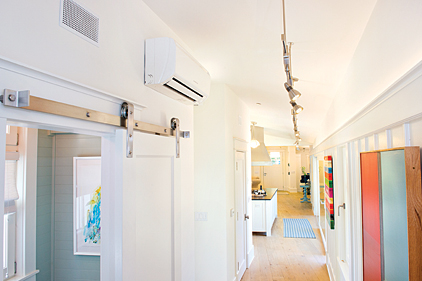
|
| Customer awareness of ductless systems is helping contribute to growth patterns seen in residential and commercial ductless applications. (Photo by Ned Bonzi Photography.) |
Outer Banks Heating and Cooling just wrapped up one ductless install, is working on two additional installations, and will begin work on yet another mini-split work order very soon. The Kill Devil Hills, N.C.-based HVACR contractor has plenty of experience installing and servicing the units, and predicts a fuller agenda moving forward.
“With ductless equipment, we are able to do jobs that cannot otherwise be done,” said Brian McDonald, general manager. “We find the equipment to be beneficial both for the customer and for us, especially in areas either inaccessible by ductwork or for additions too small for a 1.5-ton system.”
Although growing in popularity, ductless installs aren’t something all contractors consider.
Boasting great success, McDonald believes that just about every contractor could benefit by offering ductless equipment.
“These units are no more difficult to deal with than any other equipment available,” he explained. “We just finished a two-story oceanfront addition on an existing house using two ducted fan coils on a single-inverter drive, mini-split outdoor unit. It was the least obtrusive way to do the job and we had multiple small rooms on each level of the addition.”
Mutually Beneficial
Rich Dykstra Jr., comfort specialist at D.M. Dykstra and Co., Midlothian, Ill., agrees and pointed out that the general public is beginning to recognize ductless equipment.
“I feel that the general awareness of ductless systems has increased significantly in the U.S. over the past decade,” said the Illinois contractor. “This is making it easier to transition customer conversations from traditional forced-air systems over to ductless when the situation warrants it.”
D.M. Dykstra and Co., with locations in Crestwood, Naperville, and Lombard, Ill., has worked with ductless equipment for more than 20 years. The ductless sector of the business accounts for 2-4 percent of total business.
“Offering ductless equipment has allowed us to edge out the competition that is not willing to offer the product line,” said Dykstra. “I don’t know if it is out of fear of pricing or just plain lack of knowledge about the product, but our margins on ductless installs have always come in slightly above average with less overhead.”
Commercial Applications
Ductless equipment demand spans the residential and commercial HVACR markets.
“It’s not a cure-all,” cautioned Greg Crumpton, president and founder, AirTight, Charlotte, N.C. “We have been installing these systems for the past 10 years, mainly in small data closets. Now, it is becoming more common to install them for comfort cooling as well.”
Accounting for 5 percent of his business and growing, Crumpton describes ductless equipment as another tool in his company’s bag of problem-solving options. AirTight promotes the equipment to customers citing its ease of installation and reduced space requirements. The company has installed a ductless unit at its Experience Center — a place where customers can visit and learn about different mission-critical infrastructure, HVACR solutions, and facility items.
“Space usage is important to many of our commercial customers and installing these units over the door, which is usually unused space, has brought us success,” explained Crumpton. “Once a customer sees the unit they become interested, and as long as it is the right application, we will install it.”
The definitive future of the commercial ductless market is not something that can be easily predicted. However, based on trends and personal experience, Crumpton foresees an uptick in ductless requests and installations now and in the near future.
“We will likely continue to see more and more of the equipment, especially the VRF [variable-refrigerant flow] systems,” he said. “They make good sense, even more so in retrofitted environmental or historical buildings where space conditions are sensitive, but room and access are at a premium.”
Mechanical Service Inc., Orlando, Fla., has two decades of experience with ductless equipment and Dennis Purvis, service and accounts manager, is expecting ductless specifications to increase too.
“Systems with multiple air handlers running off a single condenser will be increasing,” he said. “Right now, ductless is only about 3 percent of our business. We don’t see them very often, but they are a great fit for some applications.”
Finding a Niche
The versatility of ductless equipment makes it suitable for multiple applications. Some contractors, like Royal Air Systems Inc. in North Reading, Mass., have found ductless growth in a niche application. For Royal Air, that niche is sun porch additions. Overall ductless installs account for 15 percent of the company’s business, and the popularity of sun porch additions has largely contributed to that percentage.
Ups and Downs
One of the more popular upsides is the convenience and quiet operation of the system. Not having to deal with ductwork may help reduce the labor and overall costs.
McDonald pointed out that while the installation process may be a cinch, service and maintenance can provide a formidable challenge.
“A complex problem on a ductless unit could be difficult to deal with,” he explained. “However, most of the major manufacturers offer good service help lines to answer questions. Between that and our training, we are able to handle repairs.”
The more training they attend, the less likely they are to encounter issues in the field.
“Continual training from manufacturers and local suppliers is a must for ductless installers, service technicians, and salespeople,” said Dykstra. “Product choices are very broad and knowledge makes the process of selling, installing, and maintaining much more efficient for the customer and the contractor.”
Future of Ductless
Many contractors agree that ductless equipment is bound to increase in popularity. Those that are installing mini-splits are utilizing the option as a way to boost their bottom lines and provide the customer with yet another comfort solution.
“Any time you can have multiple offerings it is a benefit to the customer, the company, and the bottom line,” said Will Winchester, service manager for Poudre Valley Air in Fort Collins, Colo. “The major manufacturers are continually improving and developing new things to fit more applications and ductless equipment is becoming more commonplace. I definitely see this market increasing in years to come.”
Publication date: 4/29/2013
Want more HVAC industry news and information? Join The NEWS on Facebook, Twitter, and LinkedIn today!











